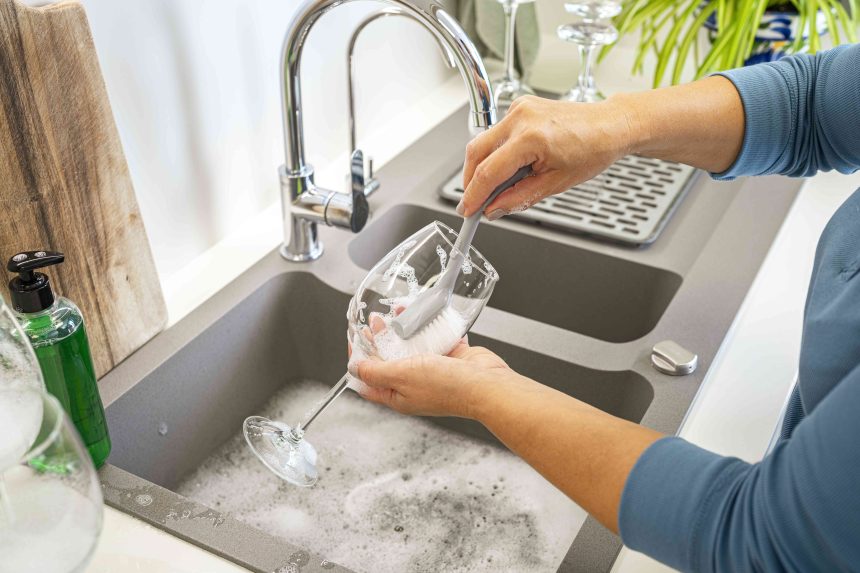Washing wine glasses can be a nerve-wracking endeavor: One wrong move and disaster can strike. No one wants an accident in the kitchen, particularly not one involving glass. The good news is that there are easy ways to safely wash wine glasses by hand and leave them sparkling clean.
While washing delicate wine glasses by hand is the best choice, many glass and plastic wine glasses can be washed in the dishwasher. This guide covers how to properly load glasses to avoid breakage, which dishwasher settings to use, and tips for ensuring wine glasses come out spot-free.
Tips for Washing Wine Glasses by Hand
Washing wine glasses by hand is the ideal way to clean them, even if they are dishwasher-safe. Following these instructions will help you get the job done right, while avoiding the accidents that can happen when delicate glassware meets slippery soap and slick wet hands.
Line the Sink with a Towel
To prevent breakage, chipping, and other damage when washing glass or crystal wine glasses by hand, line the basin of the sink with a dishcloth to provide padding and help protect shatter-prone glass from breaking.
Wash Wine Glasses in an Empty Sink
When hand-washing items like wine glasses that are easily broken, work in an empty sink to eliminate the chance of damage caused by two pieces hitting each other. Place dirty wine glasses on one side of the sink, and designate another space to place them on a clean, dry towel once they’ve been washed and rinsed.
Hold the Glass by the Bowl
When washing stemmed wine glasses, hold them by the bowl for a secure grip that will help to prevent accidental breakage.
Wash with Mild Soap and Warm Water
Delicate wine glasses are sensitive to temperature and should be washed in warm water; avoid the use of overly hot water. Additionally, take care not to use more soap than necessary, as soap residue will leave wine glasses looking dull and feeling sticky. Rinse wine glasses well after washing to ensure soap residue doesn’t linger.
Avoid Abrasive Sponges and Cleaning Agents
Abrasive sponges or brushes can scratch glass or crystal, leaving etching that creates a dull appearance. Similarly, cleaning agents that contain abrasives, such as The Pink Stuff, should not be used to clean delicate wine glasses or crystal pieces.
Use a Bottle Brush to Clean Hard-to-Reach Buildup
Use a soft bristle bottle brush to wash out buildup or scrub stains in high-walled wine glasses and champagne flutes. Don’t have a bottle brush on hand? Grab a fork, chopstick, or skewer, wrap it in a microfiber cloth, and use it to agitate any buildup clinging to the bottom of the glass.
To prevent stains from buildup from forming, rinse wine glasses with warm water before placing them near the sink to be washed. That way, if you’re not able to get to washing them right away, you’ll at least protect them from developing deep stains.
Dry Immediately
To prevent water spots, dry wine glasses immediately after washing with a clean lint-free dish towel. This is especially important if you live in an area with hard water, as the minerals in hard water can leave scratches or etching on glass.
How to Wash Wine Glasses in the Dishwasher
Many glass and plastic wine glasses are dishwasher-safe, saving you the time of washing them by hand. To get the best possible results, and to avoid damage, follow these guidelines for safely and successfully washing wine glasses in the dishwasher.
Check if the Glasses are Dishwasher-Safe
Wine glasses that can be cleaned in the dishwasher will usually feature a dishwasher-safe designation on the bottom of the glass. If not, look for care instructions on the original packaging or on the manufacturer’s website. If there is no indication that the glass is dishwasher-safe, you can assume that it is not and that it should be washed by hand. This is especially true of plastic wine glasses intended for use on boats or in pools, which are often not dishwasher-safe, despite being plastic.
Crystal wine glasses and other crystal pieces should never be cleaned in the dishwasher. Always wash crystal by hand in warm water to prevent damage to the delicate material.
Leave Space Between Wine Glasses
When loading wine glasses into the dishwasher, leave space between the glass and any other item. Wine glasses should not be touching anything other than the dishwasher rack to avoid breakage.
Use Stemware Clips
Many dishwashers come with small clips affixed to the top rack, which are designed to go around the stems of wine glasses to hold them in place during the wash cycle. If your dishwasher has these clips, use them; if your dishwasher does not have stemware clips, silicone wine glass holders made for dishwashers can be purchased separately.
Lower the Top Rack to Make Room
Ideally, wine glasses should be washed in the top rack of the dishwasher, but tall-stemmed glasses don’t always fit. Many dishwashers allow users to raise or lower the top rack to accommodate larger items. If your dishwasher has this feature, lowering the top rack can make more room for wine glasses without having to resort to the use of the bottom rack.
Use the Lower Rack as a Last Resort
If absolutely necessary, wine glasses can be placed in the lower rack of the dishwasher. To protect against breakage, take extra care to ensure wine glasses are not touching any plates, bowls, or cutlery.
Avoid a Heated Dry Cycle
Wine glasses should not be exposed to overly hot water or steam, which can weaken or break the delicate glass. Therefore, when using a dishwasher to clean wine glasses, do not use the heated dry setting. If one is available, choose the dishwasher’s gentle cycle or glassware setting, which uses lower water temperature and pressure to help reduce the risk of chipping, cracking, shattering, or scratching.
Use a Rinse Aid
Rinse aid use surfactants to lower the surface tension of water during the rinse cycle, allowing it to slide off dishes and aiding draining in the dishwasher. Using this liquid dishwasher boosting agent in addition to regular dishwasher detergent helps to reduce the appearance of water spots, streaks, and chalky white residue.
Dry Glassware Immediately
After the dishwasher cycle is done, dry the wine glasses with a lint-free towel to prevent water from drying on the glass and leaving spots.
How to Remove Cloudy Film on Wine Glasses
To reverse cloudiness in wine glasses caused by soap residue, or to remove stubborn wine stains, soak the glasses in a solution of distilled white vinegar and water. If you live in an area with hard water, using filtered water is recommended to avoid prolonged exposure of the glass to minerals that can cause etching. Allow the glassware to soak, undisturbed, for one to two hours, then wash and dry as usual.
This method will not remove cloudiness caused by scratches or etching in glass.
Regardless of whether you choose to wash by hand or to let the dishwasher do the work for you, wine glasses should be washed after every use; wine glasses that are used infrequently should be washed at least once a year to maintain them.







